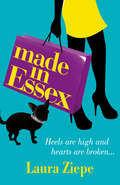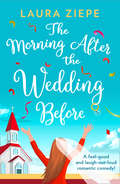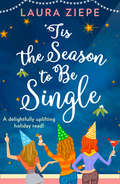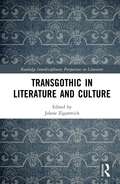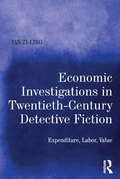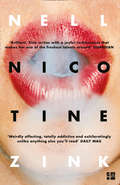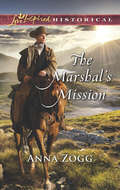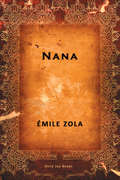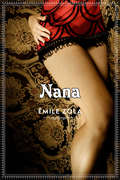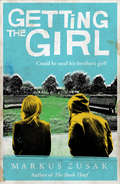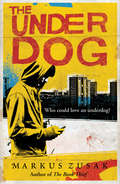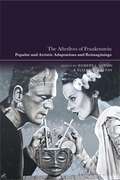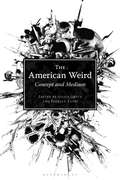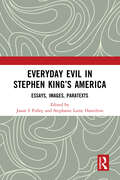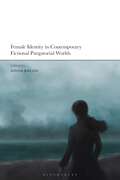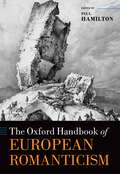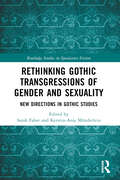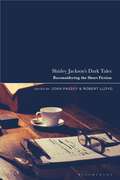- Table View
- List View
The Morning After the Wedding Before
by Laura Ziepe‘The ideal poolside read!’ The Writing Garnet Did she really say ‘I do’?!
‘Tis the Season to be Single
by Laura ZiepeA delightfully feel-good festive story! All they want for Christmas…
TransGothic in Literature and Culture (Routledge Interdisciplinary Perspectives on Literature)
by Jolene ZigarovichThis book contributes to an emerging field of study and provides new perspectives on the ways in which Gothic literature, visual media, and other cultural forms explicitly engage gender, sexuality, form, and genre. The collection is a forum in which the ideas of several well-respected critics converge, producing a breadth of knowledge and a diversity of subject areas and methodologies. It is concerned with several questions, including: How can we discuss Gothic as a genre that crosses over boundaries constructed by a culture to define and contain gender and sexuality? How do transgender bodies specifically mark or disrupt this boundary crossing? In what ways does the Gothic open up a plural narrative space for transgenre explorations, encounters, and experimentation? With this, the volume’s chapters explore expected categories such as transgenders, transbodies, and transembodiments, but also broader concepts that move through and beyond the limits of gender identity and sexuality, such as transhistories, transpolitics, transmodalities, and transgenres. Illuminating such areas as the appropriation of the trans body in Gothic literature and film, the function of trans rhetorics in memoir, textual markers of transgenderism, and the Gothic’s transgeneric qualities, the chapters offer innovative, but not limited, ways to interpret the Gothic. In addition, the book intersects with but also troubles non-trans feminist and queer readings of the Gothic. Together, these diverse approaches engage the Gothic as a definitively trans subject, and offer new and exciting connections and insights into Gothic, Media, Film, Narrative, and Gender and Sexuality Studies.
TransGothic in Literature and Culture (Routledge Interdisciplinary Perspectives on Literature)
by Jolene ZigarovichThis book contributes to an emerging field of study and provides new perspectives on the ways in which Gothic literature, visual media, and other cultural forms explicitly engage gender, sexuality, form, and genre. The collection is a forum in which the ideas of several well-respected critics converge, producing a breadth of knowledge and a diversity of subject areas and methodologies. It is concerned with several questions, including: How can we discuss Gothic as a genre that crosses over boundaries constructed by a culture to define and contain gender and sexuality? How do transgender bodies specifically mark or disrupt this boundary crossing? In what ways does the Gothic open up a plural narrative space for transgenre explorations, encounters, and experimentation? With this, the volume’s chapters explore expected categories such as transgenders, transbodies, and transembodiments, but also broader concepts that move through and beyond the limits of gender identity and sexuality, such as transhistories, transpolitics, transmodalities, and transgenres. Illuminating such areas as the appropriation of the trans body in Gothic literature and film, the function of trans rhetorics in memoir, textual markers of transgenderism, and the Gothic’s transgeneric qualities, the chapters offer innovative, but not limited, ways to interpret the Gothic. In addition, the book intersects with but also troubles non-trans feminist and queer readings of the Gothic. Together, these diverse approaches engage the Gothic as a definitively trans subject, and offer new and exciting connections and insights into Gothic, Media, Film, Narrative, and Gender and Sexuality Studies.
Economic Investigations in Twentieth-Century Detective Fiction: Expenditure, Labor, Value
by Yan Zi-LingIn his study of Golden Age and hard-boiled detective fiction from 1890 to 1950, Yan Zi-Ling argues that these two subgenres can be distinguished not only by theme and style, but by the way they structure knowledge, value, and productive labour. Using the detective as a reference point and enactor of socially based interests, Yan shows that Golden Age texts are distinguished by their conservationism (and not only by their conservatism), with the detectives’ actions serving to stabilize institutions with specific ideological aims. In contrast, the criminal investigations of the hard-boiled detective, who is poorly aligned with institutions and strong interest groups, reveal the fragility of the status quo in the face of escalating cycles of violence. Key to Yan’s discussion are theories of exchange, value, and the gift, the latter of which he suggests is more akin to detective work than is wage labour. Analyzing texts by a wide range of authors that includes Arthur Conan Doyle, Agatha Christie, Dashiell Hammett, Raymond Chandler, Dorothy Sayers, Raoul Whitfield, George Harmon Coxe, and Mickey Spillane, Yan demonstrates that the detective’s truth-generating function, most often characterized as a process of discovery rather than creation, is in fact crucial to the institutional and class-based interests that he or she serves.
Economic Investigations in Twentieth-Century Detective Fiction: Expenditure, Labor, Value
by Yan Zi-LingIn his study of Golden Age and hard-boiled detective fiction from 1890 to 1950, Yan Zi-Ling argues that these two subgenres can be distinguished not only by theme and style, but by the way they structure knowledge, value, and productive labour. Using the detective as a reference point and enactor of socially based interests, Yan shows that Golden Age texts are distinguished by their conservationism (and not only by their conservatism), with the detectives’ actions serving to stabilize institutions with specific ideological aims. In contrast, the criminal investigations of the hard-boiled detective, who is poorly aligned with institutions and strong interest groups, reveal the fragility of the status quo in the face of escalating cycles of violence. Key to Yan’s discussion are theories of exchange, value, and the gift, the latter of which he suggests is more akin to detective work than is wage labour. Analyzing texts by a wide range of authors that includes Arthur Conan Doyle, Agatha Christie, Dashiell Hammett, Raymond Chandler, Dorothy Sayers, Raoul Whitfield, George Harmon Coxe, and Mickey Spillane, Yan demonstrates that the detective’s truth-generating function, most often characterized as a process of discovery rather than creation, is in fact crucial to the institutional and class-based interests that he or she serves.
Nicotine
by Nell ZinkFrom the much acclaimed author of MISLAID and THE WALLCREEPER, a fierce and audaciously funny novel of families—both the ones we’re born into and the ones we create—a story of obsession, idealism, and ownership, centered around a young woman who inherits her bohemian late father’s childhood home.
The Marshal's Mission: The Nanny's Temporary Triplets Her Cherokee Groom An Unlikely Mother The Marshal's Mission (Mills And Boon Love Inspired Historical Ser.)
by Anna ZoggLawman with a Secret
Nana (Coll. Diamant)
by Émile ZolaNana is the story of Nana Coupeau's rise from street prostitute to high-class escort. Emile Zola's classic novel depicts a woman who starts off with nothing but uses her body and sensual skills to rise from the gutter to the top of society, destroying every man who wants her along the way.
Nana (Coll. Diamant)
by Emile ZolaNana is the story of Nana Coupeau's rise from street prostitute to high-class escort. Emile Zola's classic novel depicts a woman who starts off with nothing but uses her body and sensual skills to rise from the gutter to the top of society, destroying every man who wants her along the way.
Getting the Girl (Underdogs #3)
by Markus ZusakRube never loved any of them. He never cared about any of them. He just wanted each one because she was next, and why not take the next thing if it was better than the last? Needless to say, Rube and I aren't too much alike when it comes to women.Cameron and Ruben have always been loyal brothers, but that loyalty is about to be tested to the limit when Cam falls for Octavia - Rube's latest girlfriend. Will he get the girl? Will his love for her tear their brotherly bond apart? And would Octavia ever go for a guy like him anyway?
The Underdog (Underdogs #1)
by Markus ZusakMy name’s Cameron Wolfe. I have a little bit of sense. I don’t have much sense. My older brother Ruben gets me into plenty of trouble. I get Rube into as much trouble as he gets me into. I have a family, yes, that doesn’t really function without tomato sauce. That’s me.Cameron and Ruben Wolfe are brothers. They spend most of their time throwing one-handed boxing matches (they only have the one pair of gloves) and plotting to rob the local dentists. But what Cameron really wants is to meet a girl – a real girl, not like the ones in the lingerie magazines. But who could ever love an underdog like Cameron Wolfe?
The Afterlives of Frankenstein: Popular and Artistic Adaptations and Reimaginings
An exploration of the treatment of Mary Shelley's Frankenstein in popular art and culture, this book examines adaptations in film, comics, theatre, art, video-games and more, to illuminate how the novel's myth has evolved in the two centuries since its publication. Divided into four sections, The Afterlives of Frankenstein considers the cultural dialogues Mary Shelley's novel has engaged with in specific historical moments; the extraordinary examples of how Frankenstein has suffused our cultural consciousness; and how the Frankenstein myth has become something to play with, a locus for reinvention and imaginative interpretation. In the final part, artists respond to the Frankenstein legacy today, reintroducing it into cultural circulation in ways that speak creatively to current anxieties and concerns.Bringing together popular interventions that riff off Shelley's major themes, chapters survey such works as Frankenstein in Baghdad, Bob Dylan's recent “My Own Version of You”, the graphic novel series Destroyer with its Black cast of characters, Jane Louden's The Mummy!, the first Japanese translation of Frankenstein, “The New Creator”, the iconic Frankenstein mask and Kenneth Brannagh's Mary Shelley's Frankenstein film. A deep-dive into the crevasses of Frankenstein adaptation and lore, this volume offers compelling new directions for scholarship surrounding the novel through dynamic critical and creative responses to Shelley's original.
The American Weird: Concept and Medium
Hitherto classified as a form of genre fiction, or as a particular aesthetic quality of literature by H. P. Lovecraft, the weird has now come to refer to a broad spectrum of artistic practices and expressions including fiction, film, television, photography, music, and visual and performance art. Largely under-theorized so far, The American Weird brings together perspectives from literary, cultural, media and film studies, and from philosophy, to provide a thorough exploration of the weird mode. Separated into two sections – the first exploring the concept of the weird and the second how it is applied through various media – this book generates new approaches to fundamental questions: Can the weird be conceptualized as a generic category, as an aesthetic mode or as an epistemological position? May the weird be thought through in similar ways to what Sianne Ngai calls the zany, the cute, and the interesting? What are the transformations it has undergone aesthetically and politically since its inception in the early twentieth century? Which strands of contemporary critical theory and philosophy have engaged in a dialogue with the discourses of and on the weird? And what is specifically “American” about this aesthetic mode?As the first comprehensive, interdisciplinary study of the weird, this book not only explores the writings of Lovecraft, Caitlín Kiernan, China Miéville, and Jeff VanderMeer, but also the graphic novels of Alan Moore, the music of Captain Beefheart, the television show Twin Peaks and the films of Lily Amirpour, Matthew Barney, David Lynch, and Jordan Peele.
Ecogothic in Nineteenth-Century American Literature (Routledge Studies in World Literatures and the Environment)
First Published in 2017. Routledge is an imprint of Taylor & Francis, an Informa company.
Everyday Evil in Stephen King's America: Essays, Images, Paratexts
This edited collection variously interrogates how everyday evil manifests in Stephen King’s now-familiar American imaginary; an imaginary that increases the representational limits of both anticipated and experienced realism. Divided into three parts: I. The Man, II. The Monster, and III. The Re-mediator, the book offers rigorous readings of evil, realism, and popular culture as represented in a range of texts (and paratexts) from the King canon. Rich with images, a photo-essay, and appendices collecting classical texts and cultural detritus germane to King, this book moves away from viewing King’s work primarily through the lens of the “American gothic” and toward the realism that the suspense novelist’s voice (fictional and non-) and influence (literary and popular) indelibly continue to amplify, all the while complicating the traditional divide between serious literature and popular fiction.Stephen King remains perpetually popular. And he is finally receiving the academic treatment he has craved since the early 1980s. Yet still unexamined in the King critical canon is the suspense novelist’s fascination with “everyday evil.” Beyond rigorous interrogations of King’s fictional depictions of “everyday evil” by an array of scholars of different ranks living around the world (Canada, Finland, Hong Kong, the UK), the book, replete with 20 images, considers how King widens the parameters of literary production and appreciation. An integral part of the Americana that King’s five-decades-in-the-making canon configures, of course, includes King himself. King has long made use of self-referentiality in his fiction and nonfiction. Some of his nonfiction, several of our essays reveal, recirculates in paratextual form as “Prefatory Remarks” to new novels or new editions of older ones. The paratexts considered here (both across the volume and in the appendices) offer alternate ways by which to appreciate King and his sphere of influence (literary and popular). Said appendices are a grouping of King's paratexts on his writing as Bachman, appearing here, for the first time, as a cohesive collection. King's influence took off in the 1970s, as is further explored in the book-enveloping three-part photo-essay “King’s America, America’s King: Stephen King & Popular Culture since the 1970s.” About the transformative quality of “everyday evil,” the photo-essay tracks the cultural impacts of King first as an emerging author, then a pop culture phenomenon, and, finally, as an established American literary voice.Everyday Evil in Stephen King's America is designed to appeal to teachers and students of American literature, to Stephen King enthusiasts, as well as to acolytes of Americana since the Vietnam War.
Female Identity in Contemporary Fictional Purgatorial Worlds
Examining fictional purgatorial worlds in contemporary literature, film and video games, this book examines the way in which the female characters trapped within them construct identity positions of resistance and change. With the rise of populism, the Alt. Right, and isolationism in world politics in the second decade of the 21st Century, parallel, purgatorial worlds seem to currently proliferate within popular culture across all media, including television shows and films such as The Handmaids Tale, Us, Watchmen, and Margaret Atwood's The Testaments among many others. These texts depict alternate worlds that express the darkness and violence of our own, arguably none more so than for women. Featuring essays from a broad range of international contributors on topics as wide-ranging as mental health in the Silent Hill franchise and liminal spaces in the work of David Mitchell, this book is an original, timely and hope-filled analysis about overcoming the confines of a patriarchal, fundamentalist world where the female imaginative might just be the last, best hope.
Frankenstein in Theory: A Critical Anatomy
This collection provides new readings of Frankenstein from a myriad of established and burgeoning theoretical vantages including narrative theory, cognitive and affect theory, the new materialism, media theory, critical race theory, queer and gender studies, deconstruction, psychoanalysis, and others. Demonstrating how the literary power of Frankenstein rests on its ability to theorize questions of mind, self, language, matter, and the socio-historic that also drive these critical approaches, this volume illustrates the ongoing intellectual richness found both in Mary Shelley's work and contemporary ways of thinking about it.
The Oxford Handbook of European Romanticism (Oxford Handbooks)
TThe Oxford Handbook to European Romanticism brings together leading scholars in the field to examine the intellectual, literary, philosophical, and political elements of European Romanticism. The book focuses on the cultural history of the period extending from the French Revolution to the uprisings of 1848. It begins with a series of chapters examining key texts written by major writers in languages including: French; German; Italian; Spanish; Russian; Hungarian; Greek; and Polish amongst others. A second section then explores the naturally inter-disciplinary quality of Romanticism, exemplified by the different discourses with which writers of the time set up an internal, comparative dynamic. These chapters highlight the sense a discourse gives of being written knowledgeably against other pretenders to completeness or comprehensiveness of self-understanding of the time. Discourses typically advance their own claims to resume European culture, collaborating with and at the same time trying to assimilate each other in the process. The main examples featured here are: history; geography; drama; theology; language; philosophy; political theory; the sciences; and the media. Each chapter offers an original and individual interpretation of an inherently comparative world of individual writers and the discursive idioms to which they are historically subject. Together the forty-one chapters provide a comprehensive and provocative overview of European Romanticism.
Rethinking Gothic Transgressions of Gender and Sexuality: New Directions in Gothic Studies (Routledge Studies in Speculative Fiction)
From early examples of queer representation in mainstream media to present-day dissolutions of the human-nature boundary, the Gothic is always concerned with delineating and transgressing the norms that regulate society and speak to our collective fears and anxieties.This volume examines British and American Gothic texts from four centuries and diverse media – including novels, films, podcasts, and games – in case studies which outline the central relationship between the Gothic and transgression, particularly gender(ed) and sexual transgression. This relationship is both crucial and constantly shifting, ever in the process of renegotiation, as transgression defines the Gothic and society redefines transgression. The case studies draw on a combination of well-studied and under-studied texts in order to arrive at a more comprehensive picture of transgression in the Gothic.Pointing the way forward in Gothic Studies, this original and nuanced combination of gendered, Ecogothic, queer, and media critical approaches addresses established and new scholars of the Gothic alike.
Shirley Jackson’s Dark Tales: Reconsidering the Short Fiction
The first dedicated exploration of the short fiction of Shirley Jackson for three decades, this volume takes an in-depth look at the themes and legacies of her 200-plus short stories. Recognized as the mother of contemporary horror, scholars from across the globe, and from a range of different disciplinary backgrounds, dig into the lasting impact of her work in light of its increasing relevance to contemporary critical preoccupations and the re-release of Jackson's work in 2016. Offering new methodologies to study her work, this volume calls upon ideas of intertextuality, ecocriticism and psychoanalysis to examine a broad range of themes from national identity, race, gender and class to domesticity, the occult, selfhood and mental illness. With consideration of her blockbuster works alongside later works that received much less critical attention, Shirley Jackson's Dark Tales promises a rich and dynamic expansion on previous scholarship of Jackson's oeuvre, both bringing her writing into the contemporary conversation, and ensuring her place in the canon of Horror fiction.
